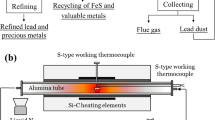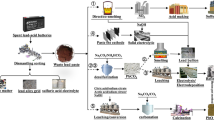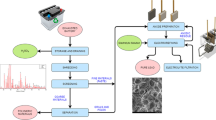Abstract
Today, all lead is produced in pyrometallurgical plants. Secondary lead production is assuming a growing importance but requires to be updated to comply with the more and more stringent regulation that is going to be implemented in the future. Engitec, involved for a long time in the development of an hydrometallurgical lead production, finally, has demonstrated that the recovery of lead from battery paste through electrochemistry is technically and economically viable through campaigns run on the FAST Pb Process demo plant. The latest development was based on the use of non-desulphurized paste learning that the presence of sulphates in the electrolyte can be controlled and is not causing any additional technical problem if not the consequent removal of sulphates from the electrolyte. This new approach heavily impacts on the new way of operating the whole battery recycling process simplifying the flowsheet through the removal of some problematic units and achieving a further reduction in the environmental impact.
Access provided by Autonomous University of Puebla. Download conference paper PDF
Similar content being viewed by others
Keywords
Introduction
We are living in the time of the “Circular Economy”, of which one of the most challenging aspects is the energy production and storage. Lead acid battery technology is one of the oldest technologies and has a bad reputation public opinion but it was, is, and will be one of the most important players in energy storage because of some unquestionable advantages versus competing systems: it is well known, inexpensive, reliable, and fully recyclable. Furthermore, the existing lead output and mine reserves, also because of the high lead recycling rates, guarantee sufficient material for future growth.
In lead production, secondary lead production overtook primary production and both the technologies had to face a lot of environmental constraints that pushed these technologies to go through significant improvements becoming safer and more environmentally friendly. The strong reduction in emissions data, as well as blood lead data within lead production plants, demonstrates that a properly operated lead production plant is no more dangerous than other metals having an infinitely better reputation than the lead. This result was possible because of the steady introduction of new processes, new equipment, and new concepts to continuously update the existing processes that, currently, are only pyrometallurgical.
Hydrometallurgical/electrochemical processes are welcome as they are more selective, more environmentally friendly, and able to reduce the emissions and the generation of wastes typical of a pyrometallurgical process.
Engitec started investigating this kind of processes since thirty years ago trying different systems and different chemical approaches till, a few years ago, the FAST Pb Process was patented.
The FAST Pb Process is a way to produce metallic lead from oxidized Pb bearing materials, in particular from lead acid battery paste, through an innovative and unconventional approach. The first application for this electrolysis was an electrochemical pre-removal of lead within Engitec’s chloride zinc electrowinning EZINEX® Process. This electrolysis was first performed in a tubular cell and was never fully developed. Unfortunately, the EZINEX® Process was limited to the first plant and was decommissioned for non-technical reasons after 4 years operation.
At the beginning, the FAST Pb Process was supposed to be used only on desulphurized paste. Paste desulphurization is a common unit in Engitec’s battery recycling process, the CX® Integrate Process, used to remove the sulphur before feeding the paste to the furnace to avoid, or at least minimize, SO2 emissions. We were concerned about building up sulphates in solution that, sooner or later, were supposed to create problems in the electrochemical system. However, after extended test campaigns, the viability of the same process using undesulphurized paste was demonstrated. Some further considerations and studies, caused us to realize this new approach, could deeply change and improve the lead acid battery recycling process.
Some other oxidized lead bearing materials were successfully tested in the demo plant built at Engitec’s laboratory demonstrating the robustness of the process.
The FAST Pb Process
The process is based on an ammonium chloride electrolyte and a flow cell, which is the true novelty of the process, where Pb is not plated in the traditional form of a sheet but in a non-adherent flake form. These Pb flakes are stripped off the cathode and transported out of the cell by the electrolyte flow. This electrolysis uses a chloride electrolyte that usually produces anodic chlorine. Engitec’s EZINEX® experience demonstrated that in the presence of ammonium/ammonia in a buffered solution, the chlorine will immediately react with ammonium producing nitrogen.
The new process is shown in the block diagram of Fig. 1.
Going through the units, in the leaching unit, in a stirred reactor, the oxidized lead compounds, including lead dioxide, are leached according to the following reactions:
PbSO4 is completely leached because of the chloride complexation. PbO2, which is not leachable in the Pb depleted solution, requires the presence of a reducing agent such as hydrogen peroxide. Concentration of ammonium chloride and temperature is fixed according to the solubility of the Pb complex. The extraction rate for the above-mentioned compounds is usually very high, quite often reaching a value higher than 98%. The kinetics depends on the grain size and the hydraulics of the reactor.
The sulphates leached and converted to (NH4)2SO4 have to be taken out of the process to avoid their build-up that will create some solubility problems as well as the development of scales along the process lines. There are some chemicals usable for this task. The most common is lime that reacts through the following reactions:
Through this reaction, we reach an equilibrium calcium-sulphate in solution that has to be controlled to avoid, or at least minimize, the possible formation of CaSO4 scales, mainly into the heat exchangers, which need a careful work to be removed.
We demonstrated in our demo plant the possibility to produce very pure lead (Pb > 99.99%). To reach this high purity, we need to remove all the impurities nobler than lead to avoid their co-plating with lead. This can be achieved through cementation using, in the cementation reactor, the electrolytic produced Pb flakes as the reactant or any kind of Pb scrap. The relevant chemical reaction is shown here below.
After the cementation, the solution now is pure enough to be fed to the electrolytic unit but needs a careful polishing filtration to remove even any particle of cement that, in the electrolytic unit, can be incorporated into the deposit decreasing its quality.
The electrowinning flow cell unit is the core of the process; it is unique and very different from the typical cells used in the traditional electrowinning.
The plating mechanism is the opposite of the traditional electrowinning cells: instead of trying to plate a very smooth lead cathode plate, in the FAST cell, we would like to produce flakes that do not strongly adhere to the cathode. These plated flakes are easily stripped off the cathode and transported out of the cell by the electrolyte flow that has to be higher than 1.5 m/s.
The cell design is very peculiar. The most important feature is the gap between the two electrodes that is very narrow for the following reasons:
-
having to reach a high linear velocity of the electrolyte, a narrow gap helps to achieve the required velocity with a reasonable pump flow rate;
-
having to reduce the ohmic drop in solution to reasonable value and being it function of the gap between the electrodes, a narrow gap reduces this ohmic drop keeping low the cell voltage and, consequently, the energy cost.
Of course, this gap has to be “big” enough to avoid the formation of short circuits that can occur when the plated Pb contacts the anode before being stripped to avoid the re-dissolution of lead decreasing the faradic efficiency.
The FAST cell was proven capable of operating at very high current densities (up to 50,000 A/m2). The best compromise for an industrial application seems to be in the range of 8000–12,000 A/m2. Due to the lead solubility, the temperature of the electrolyte in the cell, as well as one of the solutions in any other unit of the process, has to be kept quite high.
Another important peculiarity of the cell is the use of bipolar electrodes: on one face, they work as a cathode, and on the other one, they work as an anode. Some different material candidates such as graphite and some metallic electrodes were tested. These different electrode materials proved to have a strong impact on the cell design, on the adhesion to the cathode, and on the formation of anodic PbO2. For this last mentioned problem, the appropriate working conditions through the control of the free ammonia concentration of the electrolyte play a very important role.
The reactions in the cell are very similar to the ones of the EZINEX® Process. On the cathodic side of the electrode, the following reaction takes place:
producing the metallic flakes that are the product of this electrolysis. On the anodic side of the electrode, the following reaction takes place:
The chlorine management is, fortunately, not required because the anodic reaction is followed by the following very fast chemical reaction:
Some recent test on different anodes seems to demonstrate that on some of them the direct de-hydrogenation of ammonia is also possible as a competing reaction having, in any case, no impact on the process.
The overall cell reaction (8 + 9 + 10):
shows that, in the cell, the process is able to regenerate the leaching reactant to make a closed loop system. Some NH3 is consumed in the chemical reaction following the anodic reaction, and the Pb/NH3 molar ratio is the same for all the possible battery paste components.
Several factors, such as the operative current density, the solution temperature, and the electrolyte composition, impact the cell voltage. In optimized working conditions, cell voltage is in the range 2.9–3.1 V at current densities ranging between 8000 and 10,000 A/m2. The current efficiency does not depend substantially on the current density and it is between 85 and 90%, and one of the main factors for this is the narrow working gap between the anode and cathode. Some flakes can contact the anode and re-dissolve. The direct current energy consumption is between 870 and 900 kW/t of produced lead.
The flakes produced take with them some electrolyte that needs to be squeezed out, for instance by rolling or briquetting, before feeding them to a crucible for converting them into a commercial cast ingot.
Engitec’s long demonstration plant campaigns, lasting more than three years during which more than 15 tons of sulphurized paste have been treated, have provided all the data and parameters required to design the industrial cell and the complete industrial plant.
Impact of the FAST Pb Process on the Lead Acid Battery Recycling Process
Despite the tests on a lot of different lead bearing materials, this new technology was developed to take care of the lead acid battery paste because we have learned that it will have a significant impact on the overall battery recycling process, deeply impacting several unit operations in terms of future efficiency, economics, and environmental impact.
The most evolved current recycling process is the Engitec CX® Process that is highly simplified in the block diagram shown in Fig. 2.
This is a highly refined and consolidated process that has undergone extensive changes and continuous process updates. But there are still some areas to be further improved to obtain an even cleaner and environmental sound process. The most important issues are:
-
the paste smelting unit, along with slag and fumes management, which is the bigger problem as far as concerns the environmental impact;
-
the desulphurization unit where that cost of reactants is much higher than the revenues for the sulphate salt selling, and the evaporation cost is high and continuously growing;
-
not to be forgotten, the challenging market for the crystallized sulphate salt.
The introduction of the new FAST Pb Process can significantly change the entire battery recycling approach. Some of the operations indicated in the previous block diagram can be reduced, cut, and/or minimized by the introduction of this hydrometallurgical process. The process becomes simpler and more environmentally friendly as shown in Fig. 3.
As you can understand looking at Fig. 3, the process changes where it needs to change. In fact, desulphurization is not required anymore and this means to consequently cut also the sulphate solution purification and the big crystallization unit. This also means to have not anymore the problem of selling the sulphate salt.
The other big change is that the big rotary furnace used for the smelting of the paste is not required being the recovery of lead from the paste performed by the FAST Pb Process. This means also that the big baghouse taking care of the foundry is not anymore required.
There are several additional benefits to the FAST Pb Process not yet mentioned. The sulphate removal can be carried out in a dedicated unit where, using a high quality lime, a saleable gypsum can be produced. The final leaching residue contains all the antimony from the paste, so it does not transfer through to the refinery. There is a small amount of unleached lead also contained in the residue that can be treated by campaign in a small furnace where the metallic grids fraction is also recovered. The final amount of slag and ashes is very highly reduced compared to current operating techniques. There is an evaporator for the FAST Pb Process, but the capacity is much less than for desulphurization, and it is only to maintain the water balance in the FAST unit, not to produce any products.
The FAST electrowinning system is fully automated and requires a very limited labor. The process is also enclosed providing a much better workplace environment than the traditional foundry.
The process configuration for the “future” new and modern battery recycling plant is shown in the block diagram in Fig. 4.
Economics
The new configuration of a recycling plant based on the FAST Pb Process is more capital intensive than the conventional lead smelter equipped with desulphurization, rotary furnaces, and refinery kettles. The electrowinning cells themselves are not disproportionately expensive but the processes for the lead compounds leaching, the solution filtration, and purification units each require additional equipment.
However, the operational cost of the FAST Pb Process appears to be much better than conventional smelting and refinery, even when considering only the direct costs. Depending mainly upon the cost of the electric energy, the direct cost ranges between 240 and 280 Euro/ton of refined lead. The major cost savings are the labor and the logistics due to the continuous operation of the FAST versus the batch operations of conventional smelting.
While the direct cost for the operation of the health and environmental protection units has been included in the above specific cost, the fixed cost for the management of the lead fume bag houses and for the human health protection in the plant is incomparably lower for the FAST Pb Process than the cost for the conventional smelters.
Lastly, the image and respective community acceptance management are a cost for any smelter. Cleaner lead production through electrowinning is expected to be a welcome improvement by the neighbourhood as well as local and federal regulating agencies.
Conclusion
Even though lead is always considered a “dead man walking”, its importance in the energy storage market is vital and it is not likely to lose standing in the future. Of course, the image and public opinion of lead impose the need for research into safer and more environmentally friendly production methods. Electrochemistry can provide a big hand in changing this opinion.
Engitec started to study lead electrochemical recovery decades ago and has investigated many different options to treat both primary and secondary lead sources. The FAST Pb Process for secondary sources is a unique and challenging electrochemical process. Extensive laboratory, pilot, and demo plant development operations have allowed Engitec to study the system, collect the data, and reach the point of industrial plant design.
The lead acid battery was, is, and will long be the most important use of lead, the most important source for lead production, and the most important system for energy storage. The Engitec FAST Pb Process, as shown in this paper, will have a tremendous technical, economic, and environmental impact on the overall lead acid battery recycling process.
Author information
Authors and Affiliations
Corresponding author
Editor information
Editors and Affiliations
Rights and permissions
Copyright information
© 2020 The Minerals, Metals & Materials Society
About this paper
Cite this paper
Maccagni, M., Guerrini, E. (2020). The FAST Pb Process and Its Impact on Secondary Lead Production. In: Siegmund, A., Alam, S., Grogan, J., Kerney, U., Shibata, E. (eds) PbZn 2020: 9th International Symposium on Lead and Zinc Processing. The Minerals, Metals & Materials Series. Springer, Cham. https://doi.org/10.1007/978-3-030-37070-1_50
Download citation
DOI: https://doi.org/10.1007/978-3-030-37070-1_50
Published:
Publisher Name: Springer, Cham
Print ISBN: 978-3-030-37069-5
Online ISBN: 978-3-030-37070-1
eBook Packages: Chemistry and Materials ScienceChemistry and Material Science (R0)








